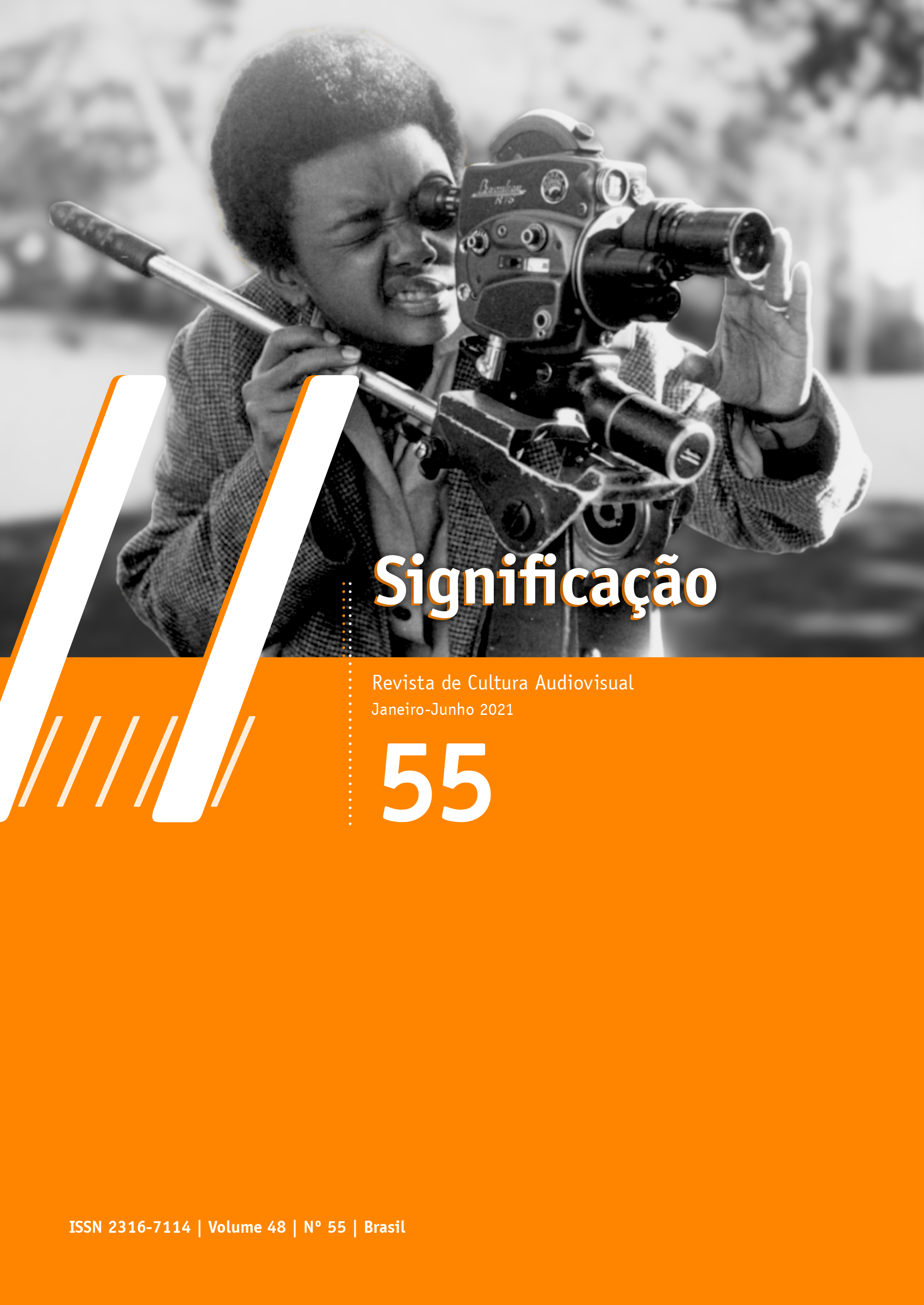Points of audition and diegesis of the chanson in cinema
DOI:
https://doi.org/10.11606/issn.2316-7114.sig.2021.160587Keywords:
Film, Popular music, Chanson, Point of auditionAbstract
Chanson is a genre of popular music heard in the cinema produced in France. By integrating a microtextual (in the sinchronous relationship between sound and image), macrotextual (inside the scene), microcontextual (in the film as a whole), and macrocontextual analysis (in the historical moment of the society in which it is inserted), three movies will be addressed. The goal is to demonstrate how chansons operate, not only in the synergy between phonographic and film industry, but also narratively, expressing characters’ emotions, catalyzing speeches and actions in the movies, and making explicit different manipulating ways of the point of audition and diegesis regime.
Downloads
References
ALVIM, L. B. “Beleza, star system e uso da música associada a personagens femininas em filmes de ficção de Agnès Varda da Nouvelle Vague”. In: LUSVARGHI, L.; ALVIM, L. B.; NASCIMENTO, G. Cinema, representação e relações de gênero. São Paulo: E-galáxia, 2018. E-book.
BUHLER, J; NEUMEYER, D. Gaumont Sound Films. Hearing the Movies, [s. l.], 4 abr. 2010. Disponível em: https://bit.ly/3nxeYN5. Acesso em: 15 ago. 2020.
CARVALHO, J. J.; SEGATO, R. L. Sistemas Abertos e Territórios Fechados: para uma nova compreensão das interfaces entre música e identidades sociais. Brasília: Universidade de Brasília, 1994. Disponível em: https://bit.ly/3q5FwHw. Acesso em: 21 jun. 2004
CHION, M. Audiovision: Sound on Screen. New York: Columbia University Press, 1994.
CONWAY, K. “Flower of the Asphalt: The Chanteuse Réaliste in 1930s French Cinema”. In: WOJCIK, P. R.; KNIGHT, A. (orgs.) Soundtrack Available: Essays on Film and Popular Music. Durham: Duke University Press, 2001a. p. 134-160.
CONWAY, K. “Diva in the Spotlight: Music Hall to Cinema”. In: HUGUES, A.; WILLIAMS J. Gender and French Cinema. Oxford: Berg, 2001b. p. 35-61.
CONWAY, K. Chanteuse in the city: the realist singer in French film. Berkeley: University of California Press, 2004.
DELEUZE, G. Imagem-Tempo. São Paulo: Brasiliense, 1990.
GOEDERT, N.; MAILLARD, N. Culture visuelle du territoire (I): Pépé le Moko et l’invention de la frontière. IMAJ, [s. l.], 10 jan. 2016. Disponível em: https://bit.ly/3pGB6Xs. Acesso em: 1 jul. 2020.
GORBMAN, C. Unheard Melodies. London: BFI Publishing, 1987.
GORBMAN, C. “Varda´s music”. Music and the Moving Image, Ann Arbor, v. 1, n. 3, 2008.
GREENE, G. “Stage and Screen, The Cinema: Pepé le Moko”. The Spectator, London, n. 5.678, p. 759 [15], abr. 1937. Disponível em: https://bit.ly/33jWSq5. Acesso em: 25 jun. 2019.
KASSABIAN, A. Hearing film: tracking identifications in contemporary Hollywood film music. New York: Routledge, 2001.
KLINE, T. J. Agnès Varda: Interviews. Jackson: University Press of Mississipi, 2014.
LACOMBE, A.; PORCILE, F. Les Musiques du Cinéma Français. Paris: Bordas, 1995.
MAIA, G.; ZAVALA, L. Cinema Musical na América Latina: aproximações contemporâneas. Salvador: EDUFBA, 2018.
MANCERON, G. Front populaire et nationalisme algérien: la rupture. Histoire colonial et postcoloniale, Paris, 22 jun. 2016. Disponível em: https://bit.ly/35ByDoZ. Acesso em: 1 jul. 2020.
NEUMEYER, D. The Oxford Handbook of Film Music Studies. Oxford: Oxford University Press, 2014.
POWRIE, P. “The Fabulous Destiny of the Accordion in French Cinema”. In: POWRIE, P.; STILWELL, R. (orgs.). Changing Tunes: the use of pre-existing music in film. Burlington: Ashgate, 2006. p. 137-151.
POWRIE, P.; STILWELL, R. (orgs.). Changing Tunes: the use of pre-existing music in film. Burlington: Ashgate, 2006.
SCHAFER, R. M. A afinação do mundo. São Paulo: Editora Unesp, 2001.
SCHAEFFER, P. Traité des objets musicaux: essai interdisciplines. Paris: Éditions du Seuil, 1966.
TOURNES, L. Du phonographe au MP3, XIXème-XXIème siècles, une histoire de la musique enregistrée. Paris: Autrement, 2008.
VIDIGAL, L. A. “A Jamaica é aqui”: arranjos audiovisuais de territórios musicados. 2008. Tese (Doutorado em Comunicação Social) – Universidade Federal de Minas Gerais, Belo Horizonte, 2008.
WOJCIK, P. R.; KNIGHT, A. (orgs.) Soundtrack Available: Essays on Film and Popular Music. Durham: Duke University Press, 2001.
Referências audiovisuais
CLÉO de 5 à 7 (Cléo de 5 às 7). Agnès Varda, França, 1962.
PEPÉ le moko (O Demônio da Algéria). Julien Duvivier, França, 1936.
SOUS le toits du Paris (Sob os telhados de Paris). René Clair, França, 1931.
Downloads
Published
Issue
Section
License
Copyright (c) 2021 Leonardo Alvares Vidigal

This work is licensed under a Creative Commons Attribution-NonCommercial 4.0 International License.
Authors who publish in this journal must agree with the following terms:
- Authors keep their copyrights and grant the journal first time publication rights, having their articles simultaneously licensed under the Creative Commons Attribution License, which allows sharing texts with authorship recognition and first publication on this journal for non-commercial purposes.
- Authors are allowed to make additional contracts, for a non-exclusive distribution of the article’s version published on this journal (e.g.: publishing in institutional repositories of articles or as a book chapter), with authorship recognition and first publication on this journal.
















